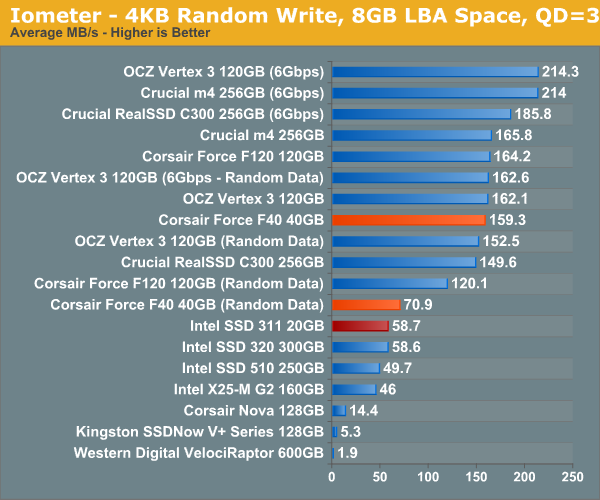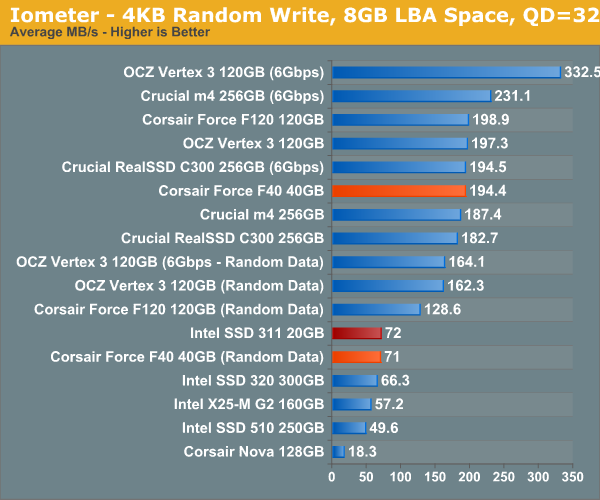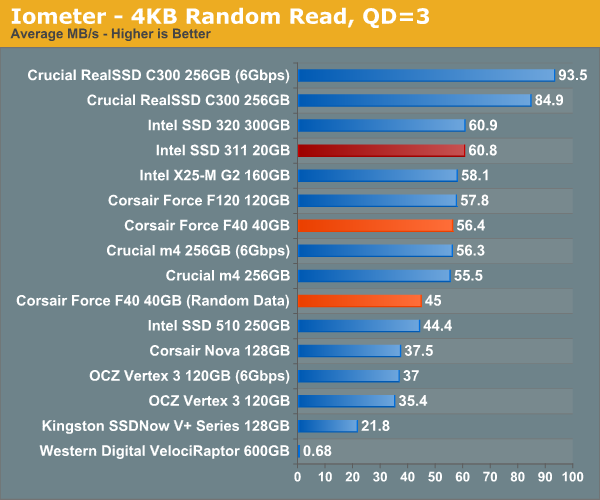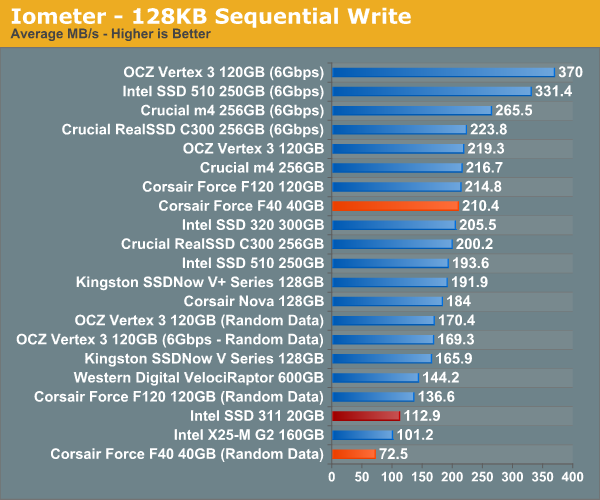Z68 SSD Caching with Corsair's F40 SandForce SSD
by Anand Lal Shimpi on May 13, 2011 3:06 AM ESTRandom/Sequential Read & Write Performance
To start with, let's look at how the Corsair Force F40 and Intel SSD 311 stack up. Remember that the F40 is based on SandForce's SF-1200 controller, meaning it gains its high performance by using real-time compression and deduplication techniques to reduce what it actually writes to NAND. Data that can easily be compressed is written as quickly as possible, while data that isn't as compressible goes by much slower. As a cache the drive is likely to encounter data from both camps, although Intel's SRT driver does filter out sequential file operations so large incompressible movies and images should be kept out of the cache altogether.
Peak sequential write performance is nearly double that of Intel's SSD 311. Toss incompressible (fully random) data at the drive however and it's noticeably slower. I'd say in practice the F40 is probably about the speed of the 311, perhaps a bit quicker in sequential writes.

For only having five NAND devices on board, Intel's SSD 311 boasts extremely high sequential read performance. At best the F40 equals it, but in reality the sequential read performance is likely a bit lower.

Random write performance is higher across the board, even with incompressible data. Random read/write performance is incredibly important for a cache, especially if most sequential data is kept off the cache to begin with. Things could be quite good for the F40 drive here.


Random read performance unfortunately doesn't look as good for the F40. Again, Intel's SSD 311 performs a lot like a X25-M G2, which happens to do very well in our random read test. At best the F40 is an equal performer, but at worst it's about 75% of the performance of the SSD 311.
Without a clear victory here, we'll likely see mixed results in our storage benchmark suite.











81 Comments
View All Comments
hechacker1 - Friday, May 13, 2011 - link
Agreed. I wonder if anybody can hack the RST 10.5 driver to make it work on any intel chipset.I actually just modded my X58 bios to include the new Intel Raid option rom, version 10.5.0.744. Guess what? The Acceleration Options shows up in the raid bios.
Unfortunately, I don't have an SSD to see if it will work.
I also tried an even newer option rom, and that Acceleration Option is now grayed out...
Either way, this is just software it seems.
Anandtech, any idea if the z68 chipset has some hardware responsible for enabling cache?
mianmian - Friday, May 13, 2011 - link
The write frequency on the catching drive is much more frequent than a normal disk. MLC might not have enough endurance to survive long under this kind of load.Shadowmaster625 - Friday, May 13, 2011 - link
I would rather just manage two drives, and move whatever I'm not using over to the media drive. It's not that hard; it only takes a couple clicks to move a folder from drive C to drive E. And for people who are scared to death of performing such types of operations, I doubt they'd see a reason to justify an extra $100. They can just suffer with a single drive solution. At least until the SSD cache is reduced to no more than a $20-$40 premium. I still think an integrated flash controller and a SSD DIMM is the way to go, and intel is shooting themselves in the foot with this half*** solution. A 10 channel SSD controller built into the cpu would be so blazingly fast...qwertymac93 - Friday, May 13, 2011 - link
Hmm, price of 40gig Corsair force = $110Price of 60gig vertex 2 = $105
... Am i missing something here?
cactusdog - Friday, May 13, 2011 - link
The features of this platform sounded great on paper but in reality a bit of a letdown.For people with a SSD this caching thing is useless.
I'm guessing AMD/Nvidia's next gen cards will have a quicksinc like performance built into their gpus, making sandy bridge/Quicksinc not so attractive.
Sata 6GBs is nice but anyone can get that speed on older boards with a pci-e ssd or just RAIDing 2 SSDs.
The only really attractive thing is unlocked CPUs for a reasonable pric but. I'm gonna skip this platform........ by the end of the year this platform will look very average.
assafb - Friday, May 13, 2011 - link
1) A more useful configuration would have been the SandForce 40GB on Enhanced mode, but it has only been tested as maximized?2) A power user would use an SSD as the boot drive naturally, SSD caching alone would be inferior, of course, but that is not all that there is to it with SSD caching for the power user. This is the question - whether the 160GB mainstream SSD buyer that has a mainstream 2TB HD would be better off with a 160GB boot drive and no caching, or with 40GB partitioned out of his 160GB SSD to cache the HD and the remaining 120GB partition for the boot drive and critical apps. This question is relevant as for many users like myself, OS+apps+games exceed 160GB, and even the unaffordable 256GB+ SSDs, so some apps and games still have to get to the mechanical HD.
Anand Lal Shimpi - Friday, May 13, 2011 - link
1) Enhanced mode should perform similarly to maximized mode in read performance. Write performance should be lower, at least on the Hitachi drive.2) If you can fit your OS and apps on the 120GB partition, then the 120/40 setup is your best bet for tackling games in my opinion.
Take care,
Anand
assafb - Saturday, May 14, 2011 - link
Thanks!sparky0002 - Friday, May 13, 2011 - link
Go for broke. Build the quickest array you can behind a z68 chipset then throw a cache infront of it. It would suck if it ended up as the limit rather than as a booster. My guess is enhanced mode will perform better.but what I really want to know is... I've lived my life inside a 60gb partition for years. Games and the like are on another disk. so how would three SSD 311's in raid 0 V's a Revodrive go? No cache just a straight test of the SLC drives.
don_k - Saturday, May 14, 2011 - link
'so how would three SSD 311's in raid 0 V's a Revodrive go'Not even close. The first gen revodrive does 500MB/s read/writes. Second gen doubles those numbers. So three 311 would give you maybe ~300MB/s at a higher price than a first gen revodrive.